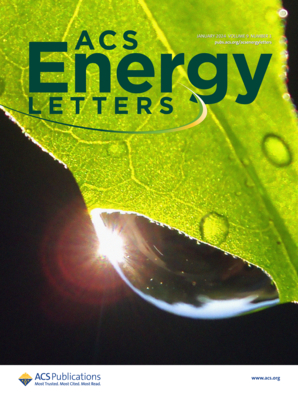反选择聚合物膜对混合阳离子盐水的电化学富集研究
IF 18.2
1区 材料科学
Q1 CHEMISTRY, PHYSICAL
引用次数: 0
摘要
具有稀量Li+的天然盐水具有吸引力,因为它们在陆地上储量丰富,可以作为电池电动汽车供应链的原料。采用Li+-反选择膜的电解膜反应器是连续去除Na+和其他金属的理想选择,提高了盐水的质量和价值。在这里,我们证明了微孔聚合物膜的选择性和阳离子交换膜的渗透性可以在固有微孔的磺化聚合物中结合起来,以克服混合阳离子分离的传统选择性-渗透性权衡。由于混合离子的作用,浓度归一化Na+/Li+的选择性达到3.03,在不到1小时的时间内,可以从Teel’s Marsh (NV, USA)的盐水样品中去除29%的Na+离子和41%的K+离子,而只提取9.5%的Li+,产生富Li废水。我们在电化学效率的背景下讨论这些结果,提供设计标准,以最大限度地减少来自竞争运输过程的损失。本文章由计算机程序翻译,如有差异,请以英文原文为准。

Electrochemical Li+ Enrichment of Mixed-Cation Brines with Antiselective Polymer Membranes
Natural brines with dilute quantities of Li+ are attractive as feedstocks for battery electric vehicle supply chains because of their onshore abundance. Electrolytic membrane reactors employing Li+-antiselective membranes are ideal for continuous removal of Na+ and other metals, upgrading brine quality and value. Here, we show that the selectivity of microporous polymer membranes and the permeability of cation exchange membranes can be combined in sulfonated polymers of intrinsic microporosity to defy conventional selectivity–permeability trade-offs for mixed-cation separations. The concentration-normalized Na+/Li+ selectivity reaches 3.03 due to mixed-ion effects, enabling the removal of 29% of Na+ ions and 41% of K+ ions from a brine sample from Teel’s Marsh (NV, USA) in less than 1 h, while only extracting 9.5% of Li+, producing a Li-enriched effluent. We discuss these results in the context of electrochemical efficiency, offering design criteria for minimizing losses originating from competing transport processes.
求助全文
通过发布文献求助,成功后即可免费获取论文全文。
去求助
来源期刊

ACS Energy Letters
Energy-Renewable Energy, Sustainability and the Environment
CiteScore
31.20
自引率
5.00%
发文量
469
审稿时长
1 months
期刊介绍:
ACS Energy Letters is a monthly journal that publishes papers reporting new scientific advances in energy research. The journal focuses on topics that are of interest to scientists working in the fundamental and applied sciences. Rapid publication is a central criterion for acceptance, and the journal is known for its quick publication times, with an average of 4-6 weeks from submission to web publication in As Soon As Publishable format.
ACS Energy Letters is ranked as the number one journal in the Web of Science Electrochemistry category. It also ranks within the top 10 journals for Physical Chemistry, Energy & Fuels, and Nanoscience & Nanotechnology.
The journal offers several types of articles, including Letters, Energy Express, Perspectives, Reviews, Editorials, Viewpoints and Energy Focus. Additionally, authors have the option to submit videos that summarize or support the information presented in a Perspective or Review article, which can be highlighted on the journal's website. ACS Energy Letters is abstracted and indexed in Chemical Abstracts Service/SciFinder, EBSCO-summon, PubMed, Web of Science, Scopus and Portico.
 求助内容:
求助内容: 应助结果提醒方式:
应助结果提醒方式:


